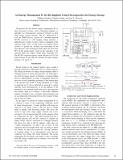An energy management IC for bio-implants using ultracapacitors for energy storage
Author(s)
Sanchez, William R.; Sodini, Charles G.; Dawson, Joel L.
DownloadDawson-An Energy Management.pdf (220.7Kb)
PUBLISHER_POLICY
Publisher Policy
Article is made available in accordance with the publisher's policy and may be subject to US copyright law. Please refer to the publisher's site for terms of use.
Terms of use
Metadata
Show full item recordAbstract
We present the first known energy management IC to allow low-power systems, such as biomedical implants, to optimally use ultracapacitors instead of batteries as their chief energy storage elements. The IC, fabricated in a 0.18 μm CMOS process, consists of a switched-capacitor DC-DC converter, a 4 nW bandgap voltage reference, a high-efficiency rectifier to allow wireless recharging of the capacitor bank, and a switch matrix and digital control circuitry to govern the stacking and unstacking of the ultracapacitors. The stacking procedure allows for more than 98% of the initial energy stored in the capacitors to be removed before the output voltage drops unsuitably low. The DC-DC converter achieves a peak efficiency of 51% for loads between 10 and 100 μW, operates for input voltages between 1.25 and 2.5 V.
Date issued
2010-09Department
Massachusetts Institute of Technology. Department of Electrical Engineering and Computer Science; Massachusetts Institute of Technology. Microsystems Technology LaboratoriesJournal
2010 Symposium on VLSI Circuits/Technical Digest of Technical Papers
Publisher
Institute of Electrical and Electronics Engineers (IEEE)
Citation
Sanchez, William, Charles Sodini, and Joel L. Dawson. “An Energy Management IC for Bio-implants Using Ultracapacitors for Energy Storage.” 2010 Symposium on VLSI Circuits/Technical Digest of Technical Papers, 2010. 63–64. © 2010 IEEE
Version: Final published version
ISBN
978-1-4244-5454-9